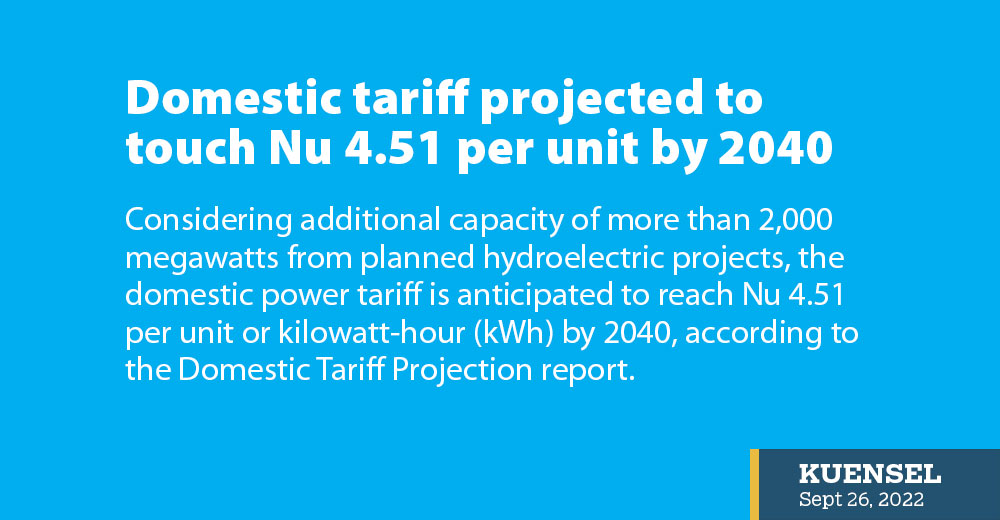Thukten Zangpo
Considering additional capacity of more than 2,000 megawatts from planned hydroelectric projects, the domestic power tariff is anticipated to reach Nu 4.51 per unit or kilowatt-hour (kWh) by 2040, according to the Domestic Tariff Projection report.
Suppose a household consumes 200 units of electricity, it has to pay Nu 532 per month at the current tariff rate of Nu 2.66 per unit for low voltage consumers. By 2040, a household has to pay Nu 902 per month with a projected tariff of 4.51 per unit.
For domestic tariff projections till 2040, five tariff cycles starting from July 2025, three-generation scenarios, and two demand scenarios were considered.
Under generation scenario I, the current generating plants, the under-construction hydropower as well as solar projects were considered, whereas in scenario II, additional capacities from planned hydroelectric projects were considered. In scenario III, further addition of two large hydropower projects were considered.
For demand scenarios, all planned loads as per the signed capacity reserve agreements or valid power sanctions are classified as scenario A, while further load addition from industries whose power clearances have been issued are taken into consideration in scenario B.
The domestic tariff was computed based on the cost-plus model using the Bhutan Electricity Authority’s Tariff Determination Regulations. In a cost-plus model, all costs related to materials, labour, and overhead are added on top of a markup percentage or profit to determine the selling price.
According to the report, the most realistic was scenario II. In this scenario, the domestic tariff was expected to increase from 2025’s prices of Nu 2.39 per unit for weighted generation price, Nu 3.38 per unit for cost of supply to Nu 3.33 per unit for weighted generation price, and Nu 4.51 per unit cost of supply by 2040.
“The average increase in generation price and cost of supply in each tariff cycle is 9 percent and 8 percent respectively,” it added.
However, the report stated that considering the uncertainty in the assumptions used, including the broad projections of the generation-load scenarios, the actual domestic tariffs might vary to a large degree.
If the industrial proponents and power utilities negotiate on the power purchase agreement-based tariff, the report stated that the tariff framework with an annual increment of around 4 to 7 percent over next 15 years (2025-2040) would be applicable.
This scenario does not take into account the evolving world energy markets. There have been frequent and steep changes in the prices of fossil fuel, especially coal, gas, and petroleum products with high inflation rates.
It is expected that Bhutan could face power shortages in the lean season because of increasing domestic demand up to 2030-2031.
The power deficit would be met from the import of power.
Assuming that India will approve the import of power from the Indian Power Exchange markets, the cost of imported power during off-peak hours in the lean months could be around Nu 4.11 per unit to Nu 6.39 per unit on average by 2040.


